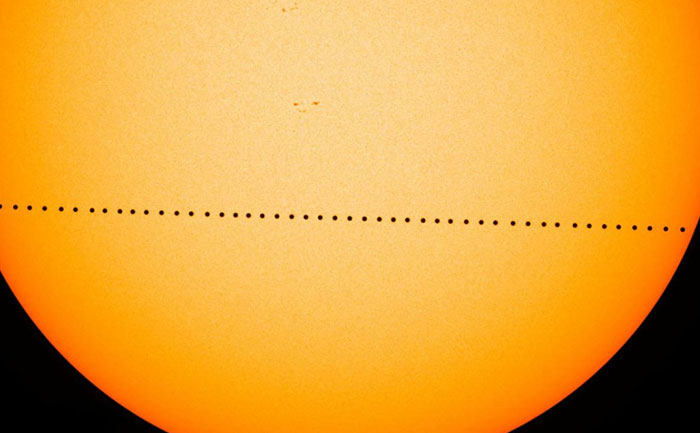Mercury will transit across the sun this Monday morning. This event will mark the last of its kind till 2032. It will require protective glasses and telescope equipment to view. During the transit, spread across a 5.5-hour stretch, Mercury will appear as a dark disc against the bright surface of the sun. Since Mercury is much farther from Earth it won’t block out the sunlight like a solar eclipse even though Mercury is 874 miles larger in diameter than the sun.
The Mercury transit will start a bit after sunrise on the East Coast and will end at 1:04 p.m. Eastern time. Europe and western Asia will experience the event during sunset. In the majority of South America, eastern United States and Canada the transit will take place during daylight with the sun being visible throughout the event. Pacific Coast will have a sunset transit. A few places will miss the Mercury transit entirely including Australia and Southeast Asia.
The next Mercury transit will occur on November 13, 2032. The transit happens 13 times in a century with a Mercury transit typically taking place in May or November. A Venus transit also occurred in 2012 with the planet appearing much clearly on the solar disk due to its proximity to the sun and earth.
How to view the Mercury transit
The small dark spot will be too small to see, even with eclipse glasses. NASA says, “Your best bet is a telescope with a certified sun filter, but other options include solar projection boxes and sun funnels.” Pinhole cameras, effective during the eclipse, will also not provide the answer in this case. However, according to Space.com, projections using protectively covered telescopes may just do the trick.
Enthusiasts should also refrain from combining eclipse glasses and binoculars as this could cause permanent eye damage to the viewer. The best way to view the Mercury transit is to live-stream it as Nasa’s Solar Dynamics Observatory will be capturing the event live.
Professor Mike Cruise, President of the Royal Astronomical Society, encourages people to experience the transit for themselves. “This is a rare event, and we’ll have to wait 13 years until it happens again. Transits are a visible demonstration of how the planets move around the Sun, and everyone with access to the right equipment should take a look, or go to an organised event if the weather is clear, or alternatively follow one of the live webcasts. I do want to stress though that people must follow the safety advice – looking at the Sun without appropriate protection can seriously damage your eyes.”
ALSO READ: Black Hole: Here Is The First Picture Of Our Milky Way’s Dark Hole

